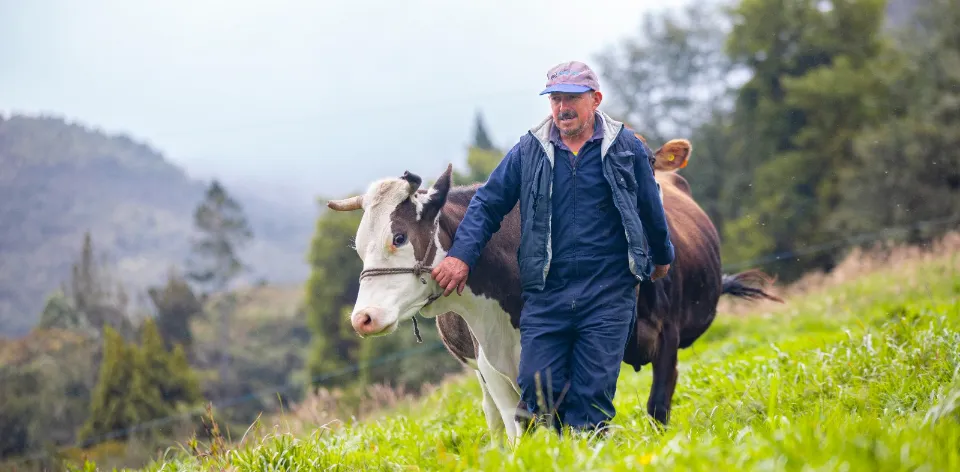 2/6/2024
2/6/2024
UPRA recognizes peasantry as subjects of rights and special protection in Colombia through Rural Planning Actions

UPRA Actions: peasant, family and community agriculture, suitability zoning, agricultural production alternatives, Productive Management Plans, the Collaborative Network of Agricultural Infrastructure (RECIA), Municipal Agricultural Evaluations (EVA), crop monitoring, Protection Areas for Food Production (APPA) and, finally, the Agricultural Territorial Kit.
Bogotá D. C., (@Minagricultura, @UPRAColombia, @claudialili76). The technical team of the Unit for Rural Agricultural Planning (UPRA), committed to supporting Colombian farmers, celebrates the contributions of men and women in rural areas on their special day. They express gratitude for the hard work, dedication, and joy these individuals bring to cultivating the land and providing food for Colombians.
To this end, UPRA continually implements actions aimed at enhancing agricultural productivity, promoting transformative technologies, developing marketing strategies, protecting the environment, and preserving rural traditions and customs.
The recognition by the state, through the Government of Change, of peasantry as subjects of rights acknowledges their economic, social, cultural, political, and environmental dimensions. This recognition represents a significant step towards swiftly resolving land tenure conflicts, facilitating access to justice for this community, and fostering a more equitable and inclusive society that values and respects the essential role of farmers in food production and environmental conservation.
"Some of the actions undertaken by the UPRA professionals for the field that target Colombian peasantry include peasant, family, and community agriculture (ACFC), suitability zonings, agroproductive alternatives, Productive Order Plans, the Collaborative Network for Agricultural Infrastructure (RECIA), municipal agricultural evaluations (EVA), crop monitoring, Food Production Protection Areas (APPA), and finally, the territorial agricultural kit."
Publication on Peasant, Family, and Community Agriculture with an Agro-Biocultural Approach
This publication analyzes the role of ACFC by identifying four categories based on self-consumption, technology use, market integration, and labor. The findings highlight the loss of land areas and cultural identity due to changes in land use and urban expansion. Additionally, the ACFC mapping has been updated with more robust methods. The ACFC represents 60.49% of agricultural production units (UPA) and is significant in many departments, although its presence is lower in Magdalena, Bolívar, and Atlántico. Notably, 16.27% of these UPAs are managed by women heads of household.
National and Territorial Suitability Zonings
UPRA has developed national zonings for beans, cassava, plantains, and beekeeping, and is working on zoning for artisanal marine fishing, irrigated rice, pumpkin, and industrial hemp in various regions. These zonings identify suitable crops and soil suitability, allowing for integrated planning that considers physical, ecosystem, economic, and social aspects while prioritizing food security and the right to adequate food.
Agroproductive Alternatives and Promising Initiatives for Peasant Reserve Areas
From the UPRA, work is being done with the peasants in the peasant reserve zones (ZRC) of Perla Amazónica on the list of prioritized agroproductive alternatives for agricultural production planning. The second work session was held with the communities at the Humanitarian Center Organization ADISPA (Integral Sustainable Development Association of Perla Amazónica), located in Vereda Bajo Cuembí, Puerto Asís, Putumayo.
In the first semester, UPRA is scheduled to work with: 1. Perla Amazónica (Puerto Asís, Putumayo) and 2. Montes de María (El Guamo, San Juan Nepomuceno, Zambrano, Córdoba, Bolívar). They will also work in the ZRCs of: 3. Losada Guayabero (La Macarena and Uribe, Meta) and 4. Arenal Morales (Arenal and Morales, Bolívar).
Productive Order Plans
In collaboration with the Ministry of Agriculture and stakeholders, UPRA has developed the Productive Order Plan for Colombian potato chains and has made collective progress on the Productive Order Plans for three productive chains: aquaculture for human consumption (tilapia, trout, cachama, and farmed shrimp), cocoa, and panela agroindustry.
Master Plans for Agroproductive Conversion
UPRA, in partnership with the Ministry of Agriculture and various producers and industry members, has developed the Master Plan for Agroproductive Conversion for the traditional corn chain and is also progressing on the Colombian potato chain. These plans provide territorialized strategies that outline actions and reference points for sustainable projections over the next 20 years.
Collaborative Network for Agricultural Infrastructure (RECIA)
Through RECIA, which involves individuals, businesses, and institutions, UPRA promotes the development of the Colombian agricultural supply chain. To date, more than 1,600 shared infrastructures have been mapped. All records undergo a quality validation process before publication, with over 40% of infrastructures currently validated. RECIA also features a dedicated portal on the entity's website for consolidating information and sharing details about agricultural infrastructures.
Municipal Agricultural Evaluations (EVA)
The results of the 2023 EVA show a 2.7% increase in cultivated areas compared to 2022, driven by a 3.1% rise in food crops. Key crops like cassava, potato, and corn saw increases of 10.5%, 4.3%, and 4.2%, respectively, while beans and some vegetables experienced declines. Production and yield rose by 2.4% and 0.5%, respectively, with notable increases in rice, corn, plantains, sugarcane, and soy.
Crop Monitoring
Crop monitoring has significantly advanced with the use of artificial intelligence and cloud processing technologies, allowing for timely and accurate data collection on various crops. UPRA has covered over 43 million hectares nationwide, processing more than 2,500 satellite images and generating over 80 Gb of data. Crops like potato, corn, and rice are monitored biannually, while cocoa and plantains are monitored annually. Monitoring reports are being consolidated for publication, enabling better understanding of crop dynamics and variations over time.
Food Production Protection Areas (APPA)
UPRA has identified APPAs in nine municipalities in La Guajira to ensure food security and protect agricultural soils. Technical meetings with local governments are underway in various regions to facilitate this process. Currently, over five work fronts are active in more than 80 municipalities, where diverse groups are identifying these areas to ensure food security and protect rural livelihoods.
UPRA’s Territorial Agricultural Kit
UPRA has implemented the Territorial Agricultural Kit, which provides guidelines to strengthen agricultural sector policies in Territorial Development Plans. Meetings have been held in various departments and municipalities to socialize these guidelines and support the formulation of Development Plans. A total of 41 sessions were conducted, including 23 in-person meetings with departments and 12 in municipalities like Acacías (Meta), Paz de Ariporo (Casanare), and Barrancas (Guajira), along with six virtual sessions for other departments.
In this way, UPRA reaffirms its commitment to Colombian farmers by building tools and strategies that strengthen and enhance the work of thousands of men and women who transform land into food, ensuring Colombia's food security and sovereignty.

